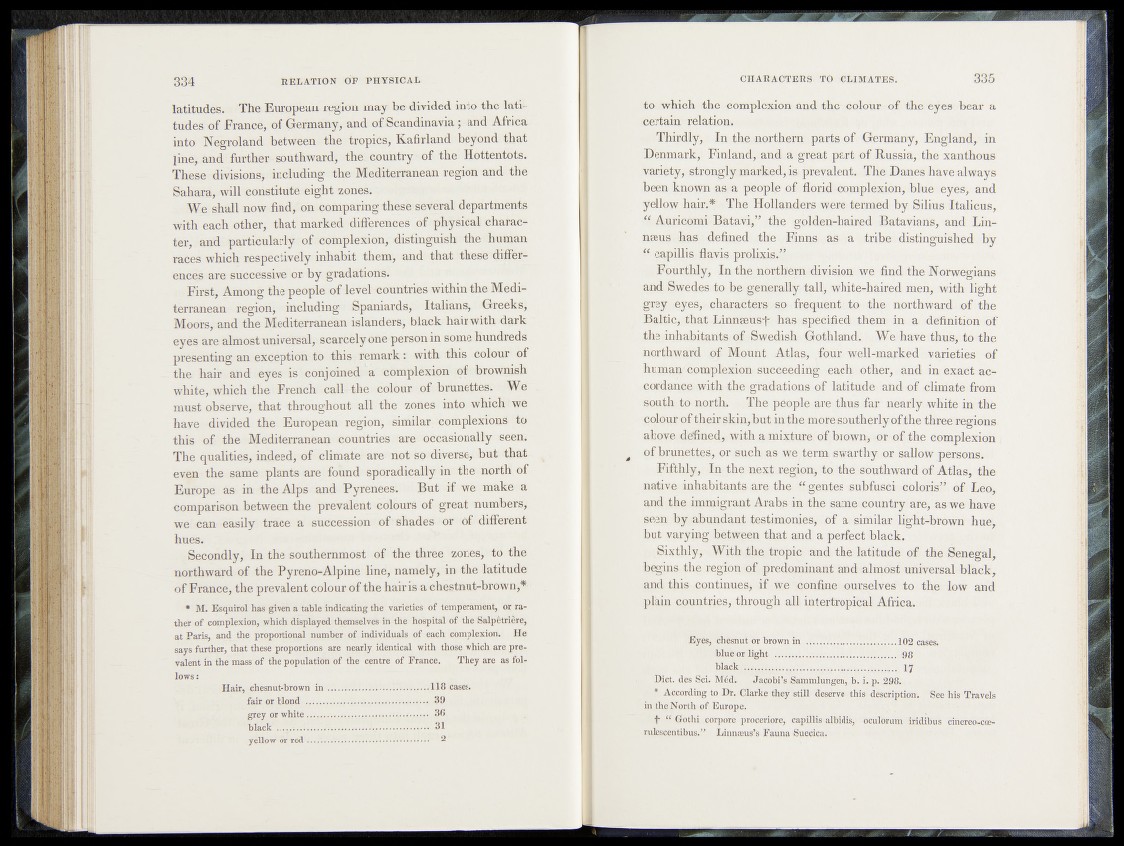
latitudes. The European region may be divided into the latitudes
of France, of Germany, and ofScandinavia ; and Africa
into Negroland between the tropics, Kafirland beyond that
jine, and' further - southward, the. countryv of the Hottentots.
These divisions# including the Mediterranean region and the
Sahara, will constitute eight zones. ‘
We shall now find, on comparing these several departments
with each other, that marked differences of physical character,
and particularly of complexion, distinguish the human
races which respectively inhabit them, and that these differences
are successive or by gradations.
First, Among the people of level countries within the Mediterranean
region, including Spaniards, Italians, Greeks,
Meors, and the Mediterranean islanders, black hair with dark
eyes are almost universal, scarcely one person in some hundreds
presenting an exception to ibis remark: with this colour of
the hair and eyes is conjoined a complexion of brownish
white, which the French call the colour of brunettes. We
must observe, that throughout all the zones into which J we
have divided the European region, similar complexions to
this of the Mediterranean countries are occasionally seen.
The qualities, indeed, of climate are not so diverse, but that
even the same plants are found sporadically in the north of
Europe as in the Alps and Pyrenees. But if we make a
comparison between the prevalent colours of great numbers,
we can easily trace a succession off shades or Of different
hues.
Secondly, In the southernmost of the three zones, to thé
northward of the Pyreno-Alpine line, namely, in the latitude
of France, the prevalent colour of the hair is a chestnut-brown,*
• M. Esquirol has given a table indicating the varieties of tempérament, or rather
of complexion, which displayed themselves in the hospital of the Salpêtrière,
at Paris, and the proportional number of individuals of each complexion. He
says further, that these proportions are nearly identical with those which are prevalent
in the mass of the population of the centre of France. They are as fol»
lows:
Hair, chesnubbrown in ........................... 118 cases.
fair or blond ................................................. 39
grey or white............................................ 36
black ............................................... ...........— 31
yellow or red .............................. .............. 2
to which the complexion and the colour of the eyes bear a
certain relation.
Thirdly, England, in
Denmark, Finland, and a great part of Bussia, the xanthous
variety, strongly marked,is, prevalent. The Danes have always
been known as a people of* florid complexion, blue eyes:, and
yellow hair.* The Hollanders were termed by Silius Italicus,
Auricomi Batavi,” the 'golden-haired Batavians, and Linnaeus
has defined the v Finns as a tribe distinguished by
^ capillis ffavis prolixis.”
Fourthly, In the northern division we find the Norwegians
and Swedes to be generally tall, white-haired men, with light
grey eyes, charactersj .sp frequent to the northward of the
Baltic, that Linneeus'f has specified them in a definition df
theinhabitants of Swedish Gothland:. We have thus, to the
northward of^ Mount Atlas, ,fonr well-marked varieties of
human' complexion succeeding -each other, and in exact accordance
with the gradations of latitude and of climate from
South to north. The péople are thus far nearly white in the
colour of their skin, but inthe more southerly pfthe three regions,
above defined, with a mixture of, brown, or of the complexion
of brunettes, or such as we term swarthy or sallow persons.
Fifthly, In the next region, to the southward of Atlas, the
native, inhabitants are the if genfes subfusci colons” of Leo,
and the immigrant Arabs in the same cóuntry are, as we have
seen by abundant testimonies# of a similar light-brown hue,
but varying between that and a perfect black.
. . Sixthly, With the tropic and the latitude of the Senegal,
begins the region of predominant and almost universal black,
and this continues# if we .confine ourselves to the low and
plain countries, through all iatertropical Africa*
Eyes, chesnut oi brown in .............................. ‘...102 cases.
blue or light .................... .............. 98
black ..................... VJ
Diet, des Sei. Méd. Jacobi’s Sammlungen,'Jj^j. \P--j2984» t.
* According to Dr, Clarke they still degèrye this d^scriptiotf. See his Travels
in the North of Europe.
+ “ Gothi corpore proceriore, capilMs albidds, oculorum iridibus cinereo-cce-
rulescentibus.” Linnasus’s Fauna Suepica.